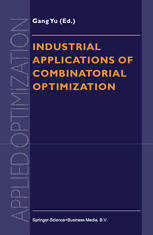Table Of ContentIndustrial Applications of Combinatorial Optimization
Applied Optimization
Volume 16
Series Editors:
Panos M. Pardalos
University ofF lorida, U.S.A.
Donald Hearn
University ofF lorida, U.S.A.
The titles published in this series are listed at the end oft his volume.
Industrial Applications
of Combinatorial
Optimization
Edited by
GangYu
Department ofM anogement Science & Information Systems,
and the Center for Manogement of Operations and Logistics,
University of Texas at Austin,
Austin, Texas, U.S.A.
SPRINGER-SCIENCE+BUSINESS MEDIA, B.V.
A c.I.P. Catalogue record for this book is avaiIabIe from the Library of Congress.
ISBN 978-1-4419-4797-0 ISBN 978-1-4757-2876-7 (eBook)
DOI 10.1007/978-1-4757-2876-7
Printed on acid-free paper
AII Rights Reserved
© 1998 Springer Science+Business Media Dordrecht
Originally published by Kluwer Academic Publishers in 1998
No part of the material protected by this copyright notice may be reproduced or
utilized in any form or by any means, electronic or mechanical,
including photocopying, recording or by any information storage and
retrieval system, without written permission from the copyright owner.
CONTENTS
PREFACE xi
ACKNOWLEDGMENTS
XV
xvii
CONTRIBUTORS
1 MOVING TOWARD AN INTEGRATED
DECISION SUPPORT SYSTEM FOR
MANPOWER PLANNING AT CONTINENTAL
AIRLINES: OPTIMIZATION OF PILOT
TRAINING ASSIGNMENTS
Gang Yu, Stacy Dugan, and Mike Arguello 1
1 Introduction 2
2 The Optimization Model 5
3 Heuristic Method for Solving the Manpower Planning Problem 11
4 Computational Results 18
5 Conclusions and Future Work 21
REFERENCES 23
2 SHORTCOMINGS OF MRP II AND A NEW
PLANNING META-METHOD
Alf Kimms and Andreas Drexl 25
1 Problem Context 25
2 Problem Outline 26
3 Current Practice 28
4 Basic Assumptions 31
5 A Mixed-Integer Programming Model 33
6 A Meta-Method 36
7 Conclusion 40
v
VI INDUSTRIAL APPLICATIONS OF COMBINATORIAL OPTIMIZATION
REFERENCES 40
3 THE DEVELOPMENT, IMPLEMENTATION
AND USE OF A PACKAGE TO FACILITATE
PLANNING AND PRODUCTION SCHEDULING
IN A TOBACCO PROCESSING PLANT
Miles G. Nicholls 44
1 Introduction 45
2 The Production Process 47
3 The Core Mathematical Model 49
4 The Development of a Management-Oriented Package for Pro-
duction Scheduling Based on the Core Mathematical Model 59
5 Implementation and Operation of the Production Scheduling
Package 68
6 Concluding Remarks 69
REFERENCES 70
4 STABILITY RADIUS OF AN OPTIMAL
SCHEDULE: A SURVEY AND RECENT
DEVELOPMENTS
Yuri N. Sotskov, Vyacheslav S. Tanaev, and Frank Werner 72
1 Introduction 73
2 The Definition of the Stability Radius 77
3 Regular Criterion 78
4 Makespan Criterion 79
5 Mean Flow Time Criterion 88
6 Example 94
7 Computational Results 96
8 Related Approaches 101
9 Conclusions 103
REFERENCES 106
5 SCHEDULING JOBS WITH SEQUENCE
DEPENDENT SETUPS ON COUPLED LINES
E. C. Sewell and J. C. Tan 109
1 Introduction 109
Contents Vll
2 Objective Function 112
3 Heuristics 115
4 Integer Program and Lower Bounds 117
5 Computational Results 120
REFERENCES 124
6 OPTIMIZING THE RADIAL COMPONENT
INSERTION OPERATIONS ON PCBS
Soo Y. Chang, Hark-Chin Hwang, and Katta G. Murty 125
1 Introduction 125
2 Problem definition 126
3 Mathematical Model 129
4 Heuristic Method 132
5 Computational experiment 139
REFERENCES 141
7 COMBINATORIAL OPTIMIZATION IN A
CATTLE YARD: FEED DISTRIBUTION,
VEHICLE SCHEDULING, LOT SIZING, AND
DYNAMIC PEN ASSIGNMENT
Moshe Dror and Janny M. Y. Leung 142
1 Introduction 142
2 The Feed Distribution Problem 147
3 Assignment of Routes to Vehicles: The Scheduling Problem 155
4 The Feedmill Operation -Synchronizing Production with Dis-
tribution 161
5 Cattle Movement 166
6 Conclusions 168
REFERENCES 169
8 OPTIMIZING A RETAIL PROMOTIONAL
CALENDAR BY MIXED INTEGER, LINEAR
PROGRAMMING
Stephen A. Smith 172
1 Introduction 172
2 Model Formulation 174
viii INDUSTRIAL APPLICATIONS OF COMBINATORIAL OPTIMIZATION
3 Specifying the Optimization Model 176
4 Conclusion 183
REFERENCES 184
9 AN IMPLEMENTATION OF A SYSTEM USING
HEURISTICS TO SUPPORT DECISIONS
ABOUT SHOP FLOOR SETUP CHANGES
Rahul De 186
1 Introduction 186
2 Overview of the Setup Change Scheduling Problem 187
3 Heuristics for Scheduling Setup Changes 192
4 Design of the Decision Support System 197
5 Implementation and Validation 199
6 Conclusion 203
REFERENCES 204
APPENDIX A 206
10 INTEGRATIVE POPULATION ANALYSIS
FOR BETTER SOLUTIONS TO LARGE-SCALE
MATHEMATICAL PROGRAMS
Fred Glover, John Mulvey, Dawei Bai, and Michael T. Tapia 212
1 Introduction 213
2 Fundamental Characteristics of Integrative Population Analysis 218
3 Computational Efficiency 227
4 Future Directions 236
REFERENCES 237
11 LAGRANGIAN RELAXATION FOR FLOW
SHOP SCHEDULING
George G. Polak 240
1 Introduction 240
2 The Disjunctive Job Shop Graph 242
3 The Flow Shop Model 244
4 Lagrangian Relaxation 247
5 A Numerical Illustration 251
6 Conclusions 253
Contents IX
REFERENCES 254
12 A HEURISTIC FOR VEHICLE ROUTING AND
MANPOWER PLANNING
George A. Bohoris and Jane M. Thomas 256
1 Introduction 256
2 Problem Requirements 258
3 Literature Review 258
4 Model Development 259
5 Model Validation 267
6 Results 268
7 Conclusions 269
REFERENCES 270
13 CONCEPTUAL DESIGN AND ANALYSIS OF
RAIL CAR UNLOADING AREA
Jonathan F. Bard 272
1 Introduction 273
2 Raw Materials Unloading Process 274
3 Study Requirements 278
4 Mathematical Model for Rail Car Unloading 279
5 Solution Approach to Unloading Problem 284
6 Design Methodology 286
7 Summary and Conclusions 299
REFERENCES 300
14 A STUDY OF THE SPACE SHUTTLE
SCHEDULING PROBLEM
Shaukat A. Brah and John L. Hunsucker 301
1 Introduction 301
2 Processing of the space shuttle 302
3 Problem description 303
4 Mathematical formulation 304
5 A simulation Study 306
6 Findings of the simulation study 308
7 Summary and conclusion 313
x INDUSTRIAL APPLICATIONS OF COMBINATORIAL OPTIMIZATION
REFERENCES 314
15 MODELS AND IMPLEMENTATION
TECHNIQUES FOR LOCAL ACCESS
TELECOMMUNICATION NETWORK DESIGN
Geon Cho and Dong X. Shaw 316
1 Introduction 317
2 Problem Description 319
3 Tree Partitioning Formulation and Limited Column Genera-
tion Procedure 324
4 Computing the LMV Reduced Cost 329
5 Solving the Subproblem for the LATN Design Problem 333
6 Solving the Subproblem for the LATN Expansion Problem 337
7 Computational Results and Data Structure 338
8 Conclusions 341
REFERENCES 342
APPENDIX A Pseudo-Code of Algorithm 2 345

